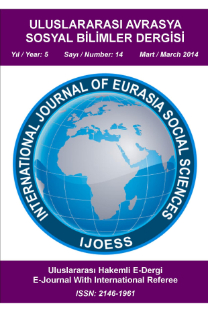THE EFFECT OF USING CARICATURES ON VOCABULARY RETENTION IN FOREIGN LANGUAGE TEACHING
YABANCI DİL ÖĞRETİMİNDE KARİKATÜR KULLANMANIN KELİME DAĞARCIĞINA KALICILIĞA ETKİSİ
___
Atasoy, Ş. ve Zoroğlu, M. A. (2014). Development and Application of Concept Cartoons for Preschool Chıldren. Necatibey Faculty of Education Electronic Journal of Science and Mathematics Education. 8(2), 38-70. 01 Ocak 2017 tarihinde http://dergipark.gov.tr./dowloand/article-file/39903 adresinden alınmıştır.Avşar, S. (2007). Tarih Öğretiminde Karikatür İmgesi. Yayınlanmamış Yüksek Lisans Tezi, Gazi Üniversitesi Eğitim Bilimleri Enstitüsü, Ankara.
Bağçeci, B. (2004). “Ortaöğretim kurumlarında İngilizce öğretimine ilişkin öğrenci tutumları (Gaziantep İli Örneği)”. XIII. Ulusal Eğitim Bilimleri Kurultayında Sunulan Sözlü Bildiri, İnönü Üniversitesi, Eğitim Fakültesi, 6- 9 Temmuz, Malatya.
Büyüköztürk, Ş. (2014). Bilimsel Araştırma Yöntemleri, Ankara: Pegem Akademi.
Csajbok-Twerefou, I. (2011). Homour in Foreign Language Teaching. Practice and Theory in Systems of Education. 6(4).327-336. 10 Mayıs 2017 tarihinde http://epa.oszk.hu/ 01400/ 01428/00018/ pdf/ EPA01428_ptse_ 1801Csajbok TwerefouIldiko. Pdf adresinden alınmıştır.
Çakır, A. ve Aydoğdu, B. (2016). Çevre Sorunları Konusunun Öğretiminde Karikatür Kullanımının Öğrencilerin Akademik Başarılarına ve Çevreye Yönelik Tutumlarına Etkisi. Batı Anadolu Eğitim Bilimleri Dergisi, 07(14), 102 – 116.
Delp, C., Jones J. (1996). “Communicating in Formation to Parents: Theuse of Cartoon İllustrations to İmprove Comprehensi on of İnstructions”. Academic Emergency Medicine. 3(3), 264-270. 10 Aralık 2016 tarihinde http:// onlinelibrary .wiley.com /doi /10.1111/j. 1553-2712.1996. tb03431 .x/ pdf adresinden alınmıştır.
Evans, V. ve Dooley, J. (2015). On Screen. Berkshire: Express Publishing.
Farah, M.J. (1988). Is Visualım a Gery Really Visual? Overlooke Devidence From Neuro Psychology. Psychological Review. 95(3), 307-317. 10 Aralık 2016 tarihinde http://dx.doi.org/10.1037/0033- 295X.95.3.307 adresinden alınmıştır.
Gömleksiz, M. N. ve Elaldı, Ş. (2000).Yabancı Dil Öğretiminde Kullanılan Yöntemler Ve Yöntem Sorunu. Fırat Üniversitesi İlahiyat Fakültesi Dergisi, 5(1), 253-264. 10 Ocak 2017 Araştırmax veri tabanından alınmıştır.
Joklová, K. (2009). Using Pictures in Teaching Vocabulary, Bachelor’s Thesis. 10 Ocak 2017 tarihinde http://is.muni.cz/th/123676/pedf_b/bachelor_thesis-using_pictures_in_teaching_vocabulary.pdf adresinden alınmıştır.
Karatay, H. (2007). Kelime Öğretimi. Ankara GÜ Gazi Eğitim Fakültesi Dergisi, 27(1), 141-153. 10 Ocak 2017 tarihinde Ulakbim veri tabanından alınmıştır.
Katchen, J. E. (1995). How to Use Cartoons in Theefl Classroom. Thai TESOL Bulletin. 8(1), 32-39. 03 Ocak 2017 tarihinde http://mx.nthu.edu.tw/~katchen/professional/cartoons.htm adresinden alınmıştır.
Kılınç, K. (2006). Tarih Öğretiminde Karikatür Materyali Kullanımının Öğrenci Başarısına Etkisi. Yayınlanmamış Yüksek Lisans Tezi, Gazi Üniversitesi Eğitim Bilimleri Enstitüsü, Ankara.
Pope, M. (2012). Karikatür Çizimi. (Çeviren: Ayşenur Parlak). İstanbul: Profil Yayıncılık.
Leiner, M.Handal, G. ve Williams, D. (2003). Patient Communication: A Multidisciplinary Approach Using Animated Cartoons. Health Education Resaarch. 19(5), 591-595. 10 Ocak 2017 tarihinde Web: http://her.oxfordjournals.org/content/19/5/591.short adresinden alınmıştır.
Naylor, S. ve Keogh, B. (2013). “Concept Cartoons: What Have We Learnt”? Journal of Turkısh Scıence Educatıon. 10(1), 3-11. 10 Ocak 2017 tarihinde http://www.tused.org/internet/tused/archive /v10/i1/tusedv10i1s1.pdf adresinden alınmıştır.
Oflaz, A. (2015). “Geleneksel ve Alternatif Yabancı Dil Öğretim Yöntemlerinde Almanca Kelime Öğretimi”. Turkish Studies. 10(3), 695-712. 10 Ocak 2018 tarihinde http://www.turkishstudies.net /makaleler/477284261_39oflazadnan-egt-695-712.pdf adresinden alınmıştır.
Patton,(2002). Qualitative Researc Hande Valuation Methods. California: Sage Publications.
Pranatha, A. N. (2005). A Study on Teaching Vocabulary By Using Cartoon at Second Grade 2F of SLTP 6 Serang. Other Thesis. University of Muhammadiyah Malang. 12 Aralık 2016 tarihinde Web:http://eprints.umm.ac.id/267/1/AStudyonTeachingVocabularyByUsingCartoonatSecondGrade2F ofSLTP6Serang.pdf adresinden alınmıştır.
Rulle, A. C. ,Sallis, D. A. ve Donaldson, J. A. (2008). Humorous cartoons made by preservice teachers fort eaching science concepts to elementary students: process and product.m. 11 Şubat 2017 tarinde Web: http://files.eric.ed.gov/fulltext/ED532956.pdf adresinden alınmıştır.
Thakur, V. S. (2015). Using Supplementary Materials in the Teaching of English: Pedagogic Scope and Applications. English Language Teaching. 8(12). 12 Aralık 2016 tarihinde http:/doi:10.5539/elt.v8n12p1. adresinden alınmıştır.
Tokcan, H. ve Alkan, G. (2013). Sosyal Bilgiler Öğretiminde Kavram Karikatürlerinin Öğrenci Başarısına Etkisi. Ahi Evran Üniversitesi Kırşehir Eğitim Fakültesi Dergisi, (KEFAD). 14(2), 1-19. 12 Aralık 2016 tarihinde http://dergipark.gov.tr/download/article-file/15882 adresinden alınmıştır.
Turhan Ağrelim, H. (2016). Çok Uyaranlı Eğitim Ortamlarının Öğrencilerin Okuduğunu Anlama ve Yazılı Anlatım Becerilerine Etkisi. Dil Eğitimi ve Araştırmaları Dergisi, 2(3), 16-50. 01 Ocak 2017 tarihinde http://dergipark.ulakbim.gov.tr/jlere/ adresinden alınmıştır.
Varışoğlu, B., Şeref, İ., Gedik, M., ve Yılmaz, İ. (2014). Deyim ve Atasözlerinin Öğretilmesinde Görsel Bir Araç Olarak Karikatürlerin Başarıya Etkisi. Karadeniz Araştırmaları, 41, 226-242. 12 Şubat 1017 tarihinde http://eprints.umm.ac.id/267/1/A_Study_on_Teaching_Vocabulary_By_Using_Cartoon_at_Second_Gr ade_2F_of_SLTP_6_Serang.pdf adresinden alınmıştır.
Yaman, H. (2010). Bir Öğretim Aracı Olarak Karikatür: Türkçe Dil Bilgisi Öğretimi Üzerine Bir Araştırma, Kuram ve Uygulamada Eğitim Bilimleri, 10(2), 1217-1242. 10 Ocak http://www.kuyeb.com/pdf/tr/11f438237c8530d28a1e1e22f8920992vaTAM.pdf 2018 tarihinde adresinden alınmıştır.
Yıldırım, A ve Şimşek, H. (2013).Sosyal Bilimlerde Nitel Araştırma Yöntemleri .Ankara: Seçkin Yayıncılık.
Webb, P., Williams, Y., Meirin, L. (2008). Concept Cartoons and Writing Frames: Developing Argumentation in South African Science Classrooms? African Journal of Research in Mathematics, Science and Technology Education. 12(1), 5-17. 08 Kasım 2016 tarihinde http://doi.org. /10.1080 /10288457 .2008. 107 40625 adresinden alınmıştır.
Van Wyk, M. M. (2011). “The Use of Cartoons as a Teaching Tool to Enhance Student Learning in Economics Education”. Jurnal of Social Science. 26(2), 117-130. 08.11.2016 tarihinde www.krepublishers.com/02- Jurnals/JSS/JSS-26-0-000-11-Web/JSS-26-2/000-11-Abst-PDF/JSS-26-2-117-11-1102-Van-Wyk-M- M/JSS-26-2-117-11-1102-Van-Wyk-M-M-Tt.pdf adresinden alınmıştır.
- ISSN: 2146-1961
- Yayın Aralığı: 4
- Başlangıç: 2010
- Yayıncı: Prof. Dr. Kadir ULUSOY
PURPOSES OF SOCIAL NETWORK USAGE AMONG SECONDARY SCHOOL STUDENTS
AYŞE NUR ALKOÇ SAYAN, NESRİN ÖZSOY
EXPERIENCE OF PRE-SERVICE SCIENCE TEACHERS ON DIALOGIC INTERACTION
THE ANALYSIS OF HAIRDRESSING PROFESSION IN TERMS OF VARIOUS SOCIAL VARIABLES
Kadir Burak SALİMOĞLU, SERDAR KÖRÜK, Tufan ÇAYKUŞ
FEN BİLGİSİ ÖĞRETMEN ADAYLARININ DİYALOJİK ETKİLEŞİME YÖNELİK DENEYİMLERİ
EXAMINATION OF PRESCHOOL EDUCATION PROGRAM IN TERMS OF MORAL COMPONENTS
Elifcan DIDIN, KEVSER TOZDUMAN YARALI
OKULA BAĞLANMA ÖLÇEĞİNİ N TÜRKÇEYE UYARLANMASI: GEÇERLİ K VE GÜVENİRLİ K ÇALIŞMASI
